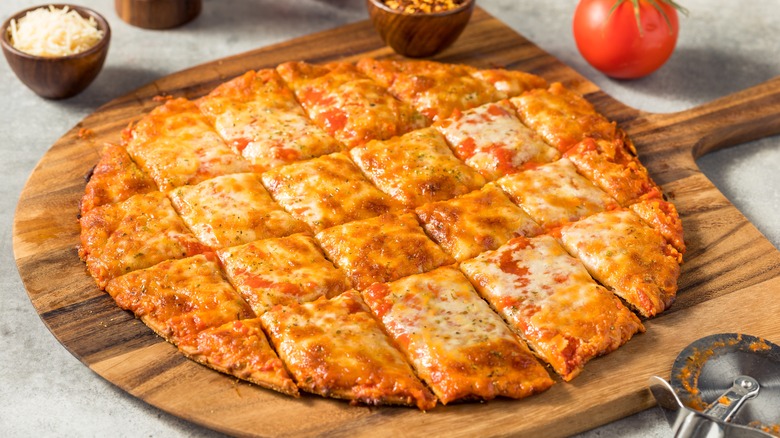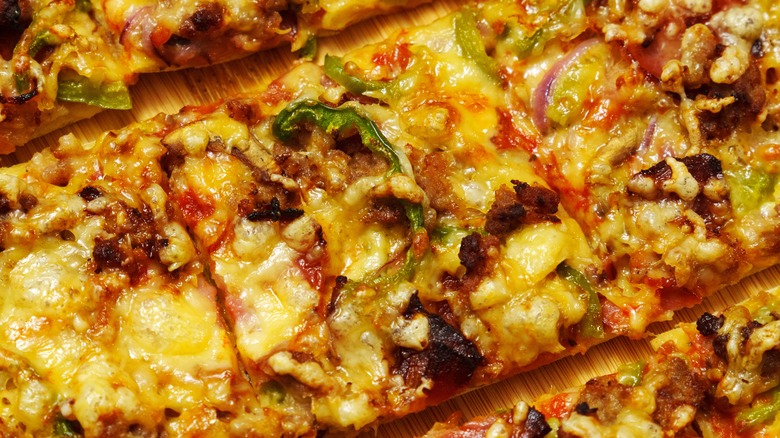The Lesser Known Type Of Chicago-Style Pizza
Anyone with even a faint knowledge of regional pizza styles probably knows about Chicago's deep dish pizza, with its high-sided crust and so many toppings (or fillings, since it's arguably closer to a pie) that you could call it a casserole. But there's another type of specialty pizza that hails from the Windy City, called tavern-style pizza — and many people contend that it's actually the pizza more Chicagoans prefer over deep dish.
If deep dish is the heaviest pizza you can imagine, tavern-style swings the pendulum far in the other direction. It features a very thin, crispy circular crust (the crust leans toward being like a large cracker), somewhat like matzah. That thin crust means that it tends not to be stacked with a bunch of toppings (it might only have one main topping in some cases). You can expect to find fairly classic pizza toppings on it: tomato sauce and cheese are standard, and sausage, pepperoni, mushrooms, and peppers are common options.
However, the one topping that sets it apart from many other American pizzas is giardiniera, a tangy Italian-style mix of pickled vegetables that often includes hot or sweet peppers, cauliflower, and carrot. It may not always be on tavern-style pizza, but it's a popular option. Another distinctive feature of tavern-style pizza is that it's cut into small rectangles or squares, not slices — and the reason for this goes back to its origins.
Why tavern-style pizza is cut into rectangles
If you looked at the words "tavern-style pizza" and guessed that it's often served in bars, then ding, ding, ding: You're correct. The precise origin of this pizza isn't clear, but it's believed to have appeared around the 1940s in local bars (the South Side bar Vito & Nick's is one famed destination for it). Historically, you wouldn't eat a whole tavern-style pizza yourself — it was intended more as a snack for working-class people drinking in bars. That explains why it's cut into squares that are far smaller than your average triangular pizza slice: It's small enough to fit into your hand, freeing up the other for drinking. This may be why it's also called "party cut" by some folks.
Back in the day, it was common for tavern-style pizza to be a free snack provided by a bar, with the goal of encouraging patrons to linger over a few more beers. It's well-known that bars often provide salty snacks — although usually smaller items like pretzels or peanuts — in the belief that they'll make you thirsty and more likely to buy more drinks. Nowadays, you'll probably pay for it, and it's not just bar food, with plenty of pizzerias focusing solely on tavern-style pizza.
Where to find tavern-style pizza
Obviously, you should have no problem finding tavern-style pizza in Chicago, and it's also somewhat prevalent in the Midwest in places like St. Louis and Milwaukee. In fact, there's a rivalry between Chicago and St. Louis over who invented this pie. Some St. Louisans argue that Chicago "stole" their pizza style. However, history suggests that a chef from St. Louis, Amedeo Fiore, started making this style of pizza popular when he moved to Chicago, before bringing it back to St. Louis. In any case, the St. Louis style is slightly different: Its crust is thinner and made without yeast, and it uses Provel cheese instead of mozzarella, which is sometimes derided as plasticky and not "real" cheese. Nonetheless, the two styles are certainly similar.
A little like Detroit-style pizza in recent years, tavern-style pizza is starting to have its moment in the spotlight. It's not exactly ubiquitous, but tavern-style pizzerias are popping up around the country, and you should be able to find it in major cities like Dallas, New York, and San Francisco, to name just a few. As in Chicago, it has moved away from being a bar food, and you're more likely to find it at a dedicated pizzeria. Otherwise, it's not hard to make yourself: It uses standard ingredients like flour and yeast, but you'll need some time to let the dough rise.


